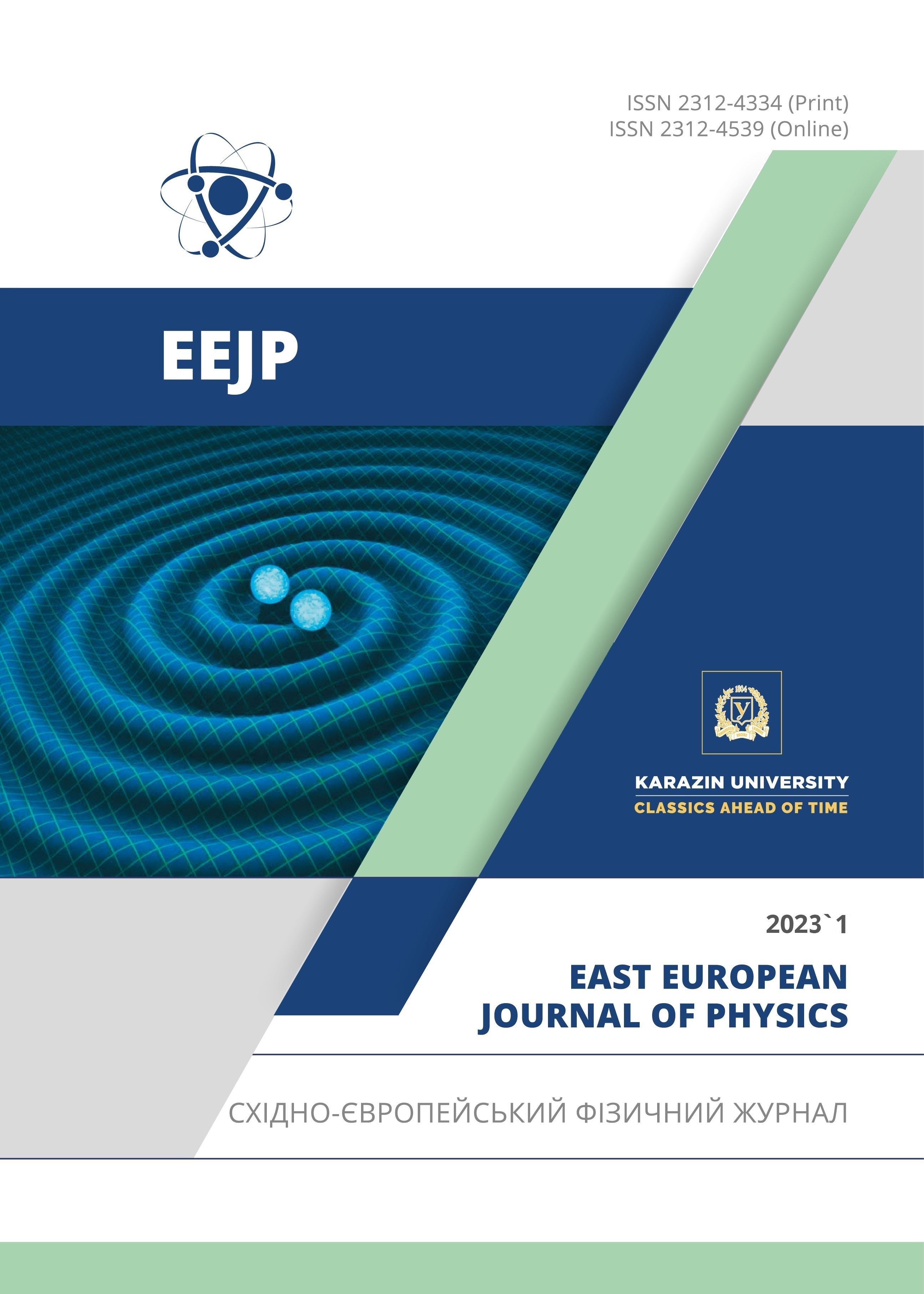Осклування імітатора кубових залишків рідких радіоактивних відходів
Анотація
В роботі проведено дослідження та обґрунтування використання оптимальних складів скла для осклування імітатору кубових залишків РРВ АЕС з реакторами ВВЕР-1000 в залежності від таких параметрів, як температура осклування, міцність, корозійна стійкість, відсутність кристалічних фаз, мінімізація скло-утворюючих добавок та включення максимальної кількості відходів. Встановлено, що температура варіння свинцево-боросилікатних скло-матриць становить 1150 °С, що задовольняє вимогам щодо осклування низько- та середньо-активних відходів. Межа міцності на стиск отриманих зразків скло-матриць становить 136.0 МПа. Також показано, що свинцево-боросилікатні скло-матриці є найбільш стійкими до вилуговування. Швидкість вилуговування цезію становить 1,5·10-5 г/см2·добу.
Завантаження
Посилання
S.Y. Sayenko, V. Shkuropatenko, A. Pylypenko, A. Zykova, S. Karsim, V. Andrieieva, and S. Moshta, PAST, 2, 103–113 (2020), https://vant.kipt.kharkov.ua/ARTICLE/VANT_2020_2/article_2020_2_103.pdf
Y.O. Olkhovyk, and P.O. Korchagin, Ядерна енергетика та довкілля [Nuclear energy and environment], 1, 20-23 (2014), http://npe.org.ua/wp-content/uploads/2019/02/3_2014.pdf. (in Ukrainian)
B.G. Ershov, T.K. Yurik, G.L. Bykov, A.V. Gordeev, P.V. Kozlov, O.M. Slyunchev, and Yu.V. Glagolenko, Вопросы радиационной безопасности [Radiation Safety Issues], 1, 3 (2008), http://bibliom.ru/wp-content/uploads/2015/06/33.pdf. (in Russian)
L. Shanggen, J. Sheng, and B. Tang, 298, 180-183 (2001). https://doi.org/10.1016/S0022-3115(01)00592-X
N.P. Laverov, B.I. Omel’yanenko, S.V. Yudintsev, S. V. Yudintsev, and S.V. Stefanovsky, Geol. Ore Deposits, 54, 1–16 (2012). https://doi.org/10.1134/S1075701512010059
N.P. Laverov, B.I. Omel’yanenko, S.V. Yudintsev, S.V. Stefanovsky, and B.S. Nikonov, Geol. Ore Deposits, 55, 71–95 (2013). https://doi.org/10.1134/S1075701513020037
I. Sobolev, M. Ojovan, T. Scherbatova, O. Batuhnova, Стекло для радиоактивных отходов [Glasses for radioactive waste]. (Energoatomizdat, Moscow, 1999). (in Russian)
M. Ojovan, and P. Poluektov, Безопасность Окружающей Среды [Environmental Safety], 1, 112-115 (2010). https://www.atomic-energy.ru/technology/33037
D.J. Backhouse, A.J. Fisher, J.J. Neeway, C.L. Corkhill, N.C. Hyatt, and R.J. Hand, npj Mater. Degrad. 2, 1-10 (2018). https://doi.org/10.1038/s41529-018-0050-5
P.A. Bingham, N.C. Hyatt, and R.J. Hand, Glass Technology: European Journal of Glass Science and Technology, Part A, 53(3), 83-100 (2012). https://doi.org/10.1038/s41529-018-0050-5
S. Gin, P. Jollivet, M. Tribet, S. Peuget, and S. Schuller, Radiochim. Acta, 105(11), 927-959 (2017). https://doi.org/10.1515/ract-2016-2658
J.S. McCloy, and S. Schuller, Comptes Rendus. Géoscience, 354, 121-160 (2022). https://doi.org/10.5802/crgeos.111
J. Shenga, K. Choi, and M. JaeSong, Journal of Nuclear Materials, 297(1), 7-13 (2001). https://doi.org/10.1016/S0022-3115(01)00598-0
K. Sawada, Y. Enokida, and T. Tsukada, Journal of Nuclear Science and Technology, 57(6), 671-677 (2020). https://doi.org/10.1080/00223131.2019.1710615
N. Krylova, and P. Poluektov, Атомная энергия [Atomic Energy], 78(2), 93-98 (1995). https://j-atomicenergy.ru/index.php/ae/article/view/4852 (in Russian)
S. Stefanovskii, Физика и химия стекла [Physics and chemistry of glass], 16 (5), 818-826 (1990). (in Russian)
U. Olihovik, Ядерна і радіаційна безпека [Nuclear and radiation safety], 4(64), 46-50 (2014). http://dspace.nbuv.gov.ua/handle/123456789/97638. (in Ukrainian)
B. Kudriavcev, U. Korchagin, and A. Reznik, Patent RU2226726C2 (2004). (in Russian)
A. Nikiforov, V. Kulichenko, and M. Jiharev, Обезвреживание жидких радиоактивных отходов [Neutralization of liquid radioactive waste], (Energoatomizdat, Moscow, 1985). (in Russian)
O. Karlina, N. Iliina, A. Ovchinnikov, and M. Ojovan, Patent RU2065215C1 (1996).
P.A. Bingham, A.J. Connelly, R.J. Hand, N.C. Hyatt, and P.A. Northrup, Glass Technol.: Eur. J. Glass Sci. Technol. A, 50(3), 135–138 (2009). https://shura.shu.ac.uk/id/eprint/5705
S. Stefanovskii, A. Minaev, and F. Lifanov, Радиохимия [Radiochemistry], 32(3), 162-166 (1990). (in Russian)
Dj. Geodokyan, and S. Stepanyan, Физика и химия стекла [Physics and chemistry of glass], 5, 622-635 (1982). (in Russian)
Отходы высокоактивные отвержденные. Общие технические требования [Highly active solidified waste. General technical requirements], GOST R 50926-96. (Gosstandart Rossii, Moscow, 1996).
M. Skvorcov, N. Mihailenko, and S. Stefanovskii, Успехи в химии и химической технологии [Advances in chemistry and chemical technology], XXXI(3), 108-110 (2017), https://cyberleninka.ru/article/n/borosilikatnye. (in Russian)
I. Levickii, L. Papko, and M. Dyadenko, Химия и технология неорганических материалов и веществ [Chemistry and technology of inorganic materials and substances], 3, 3-8 (2015). https://cyberleninka.ru/article/n/steklotsementy-dlya-vakuumplotnyh-spaev. (in Russian)
S. Stefanovskii, I. Ivanov, A. Gulin, and F. Lifanov, Радиохимия [Radiochemistry], 3, 106-109 (1993). (in Russian)
I. Sobolev, S. Dmitriev, F. Lifanov, A. Kobelev, S. Stefanovsky, and M. Ojovan, Glass Technology, 46(1), 28–35 (2005). https://www.ingentaconnect.com/content/sgt/gt/2005/00000046/00000001/art00003
V. Morgunov, S. Sayenko, V. Shkuropatenko, Y. Svitlychnyi, O. Bereznyak, S. Lytovchenko, and V. Chyshkala, “Calculation of the Absorbed Dose by a Borosilicate Glass Matrix and its simulated irradiation”, East Eur. J. Phys. 3, 121 (2022). https://doi.org/10.26565/2312-4334-2022-3-16
Авторське право (c) 2023 Сергій Ю. Саєнко, Володимир А. Шкуропатенко, Євгеній О. Світличний, Ганна В. Зикова, Світлана О. Карсім, Дмитро В. Кутній, Володимир В. Моргунов

Цю роботу ліцензовано за Міжнародня ліцензія Creative Commons Attribution 4.0.
Автори, які публікуються у цьому журналі, погоджуються з наступними умовами:
- Автори залишають за собою право на авторство своєї роботи та передають журналу право першої публікації цієї роботи на умовах ліцензії Creative Commons Attribution License, котра дозволяє іншим особам вільно розповсюджувати опубліковану роботу з обов'язковим посиланням на авторів оригінальної роботи та першу публікацію роботи у цьому журналі.
- Автори мають право укладати самостійні додаткові угоди щодо неексклюзивного розповсюдження роботи у тому вигляді, в якому вона була опублікована цим журналом (наприклад, розміщувати роботу в електронному сховищі установи або публікувати у складі монографії), за умови збереження посилання на першу публікацію роботи у цьому журналі.
- Політика журналу дозволяє і заохочує розміщення авторами в мережі Інтернет (наприклад, у сховищах установ або на особистих веб-сайтах) рукопису роботи, як до подання цього рукопису до редакції, так і під час його редакційного опрацювання, оскільки це сприяє виникненню продуктивної наукової дискусії та позитивно позначається на оперативності та динаміці цитування опублікованої роботи (див. The Effect of Open Access).








